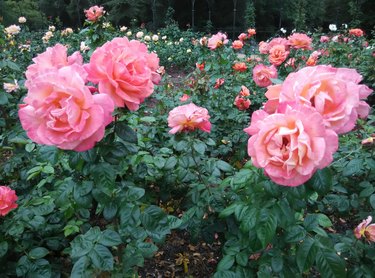
The rose (Rosa, which grows in USDA plant hardiness zones 3 through 11 depending on type) is renowned for its beauty and fragrance. They have become synonymous with elegance, and the ability to successfully cultivate a healthy rose bush is often seen as a benchmark for gardeners. While hybrids, like Floribunda roses (Rosa europeana, which grows in zones 4a to 9a), can be easier to grow due to their hardiness, there are a few tricks that are important to keep in mind while tending to these thorny blossoms. When they bloom will depend on their variety, your location and the way you care for your roses.
When Do Roses Bloom?
Video of the Day
Roses start blooming in late May and continue to do so through early fall. They are often considered to be at their best in June, which is why roses are considered June's birth flower.
Video of the Day
By deadheading weekly and pruning back to the first five-leaflet leaf below the spent blossom, you can direct your rose bush's growth and enjoy fresh flowers throughout the warmer months.
As fall approaches and you allow your roses to fruit, consider harvesting the rose hips and allowing them to dry on a screen in the sun for four to five hours. Rose hips and even flower petals can be made into delicious and aromatic teas, jams and desserts.
What Is Deadheading?
A plant's flowers evolved to attract pollinating insects. Once a plant has been pollinated, the flower has no further purpose and will wilt and fall off as the fruit of the plant grows where the flower used to be.
If you want to force a plant to blossom multiple times throughout a growing season, you will need to convince it that the flowers have not been pollinated even if they have. If you prune wilting or dead flowers before the rose can fruit (this fruit is known as rose hips), the rose bush will attempt pollination again by sprouting a new flower.
You can use this technique several times; however, you should allow the rose plant to properly fruit – or at least avoid pruning it – at least four weeks prior to the first frost. Most roses will flower every five to seven weeks as long as they have been properly deadheaded and otherwise tended to. This means that you can expect at least three blooms throughout the growing season whether the roses are planted outdoors or in pots indoors.
Planting Roses in Pots
Unfortunately, roses keep track of the seasons even if they aren't exposed to the changing temperatures outside, so indoor rose plants will become dormant during the winter months. Despite this, you may try planting roses in pots and indoors during winter if possible. While some varieties of roses can be more resistant, they are traditionally very sensitive to changes in temperature, so knowing which rose lower classifications are more hardy is important when cultivating in less temperate regions.
Roses are classified according to three primary groups. These groups are known as modern, species and old garden. They can be further divided into rather complicated subclassifications. The takeaway, however, is that you can either grow roses in pots or transplant them into pots for the winter according to your personal preference.